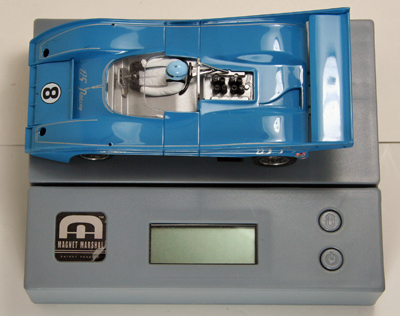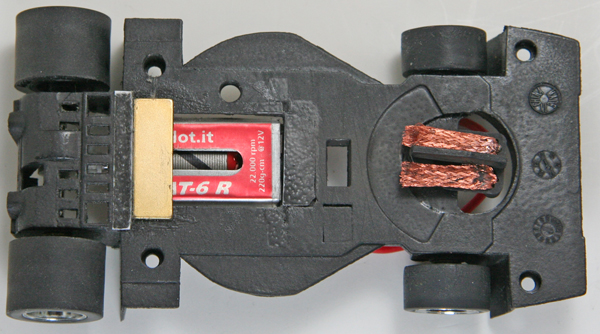Excerpt from Electric Dreams RE: Magnet Marshal
Posted: Sat Apr 13, 2013 10:18 am
Hi Guys,
I came across the following article in a recent Electric Dreams newsletter and thought it very timely and appropriate for those interested in setting up cars for our newly proposed Group 5 Sports Cars (1970-1975) class.
Gordon
Carrera McLaren M20 update

At the end of our last update we had finished the Flat 6 motor installation and lowered to body over the chassis as shown above. The next step was to work on the magnet installation.
Before getting into that it's probably a good idea to say a few words about magnetic downforce. The longest-running and most heated debate in the world of slot car racing is magnet vs. no magnet racing. We will not revisit that debate here except to note that there are vehemently held beliefs on both sides and it will never really be resolved except by the two sides simply agreeing to disagree.
However, it is interesting to look at one particular part of the issue. Perhaps the biggest (though by no means the only) knock against magnet racing is that once allowed, magnets are inevitably taken to the absolute extreme possible, resulting in cars so stuck down that they essentially don't need to be driven. This was largely true, though not without exceptions, as long as there was no uniform, reliable, and readily available means of monitoring and limiting magnetic downforce. That changed several years ago with the introduction of the Magnet Marshal.

The Magnet Marshal makes controlling downforce to any desired level utterly simple. Even better, it generates a total downforce reading that includes both car weight, including added weight, and magnetic force, allowing both the be controlled at once. Each individual tuner is free to use either or both in combination up to a single specified reading. Now, with a way to limit downforce and some creativity in magnet use it is quite possible to tune magnet cars to drive a lot more like non-magnet cars but with higher cornering limits. Those limits can be set at whatever is deemed to produce the best racing and driving qualities. What that does is to create a middle ground between the extremes. It's no longer necessarily an either-or proposition.
By the way, we are well aware that the initial 1000-unit production run of Magnet Marshals sold out quite some time ago and they are now hard to come by. The good news is that the manufacturing rights to the device are now owned by Alan Smith of Scaleracing and 132 Slotcar. He is moving toward being able to commission another production run. He told us recently that the minimum run is again 1000 units, and he needs order commitments for a large portion of that number before he can go ahead. Electric Dreams has committed to order, and if other dealers around the world will do so we will again have this very useful device available for hobbyists to purchase.
Our goal for the M20 is a Magnet Marshal reading of 300 grams. This is quite modest but can be a bit tricky to achieve on some cars. The Flat 6 installation required removing the front magnet, leaving us with only about 200 grams from the rear one. So, we have begun trying different configurations. The first one was extra magnets added on either side of the crown gear just aft of the stock magnet. That didn't really do much to help. Next, we removed the stock and added magnets and CA glued a Professor Motor 1030 1mm thick bar magnet as shown below. We first removed the motor so we wouldn't accidentally glue the motor and magnet together.

This is the thinnest bar magnet available. Even so, it caused the car to register 400 grams. What we really need now is a pair of rear tires just a little larger in diameter than the stock ones. It doesn't take much of a change in tire diameter to make a significant change in magnetic downforce. We are investigating tire options. It would be no trick if we went to aluminum wheels, but we are going to try to stick with stock plastic replacement wheels of one kind or another, at least for the time being. We should mention, by the way, that the car came to us with a pair of Maxxtrac M32 tires on it, so we simply incorporated them into the package.

As shown here, we put a piece of strapping tape over the magnet to prevent possible contact with the track. We then put the body on, leaving the screws loose for float, and went to the test track. As we expected, the car was too stuck down for our taste. It was actually at the point where it would have been better with less magnet drag on the straights. One thing really impressed us, however. Even with all that downforce, the Flat 6 motor hardly got warm, even after a half hour of more or less constant running. We will keep working with magnet and tire options until we get the Magnet Marshal number we want.
Copyright 2013 Electric Dreams
I came across the following article in a recent Electric Dreams newsletter and thought it very timely and appropriate for those interested in setting up cars for our newly proposed Group 5 Sports Cars (1970-1975) class.
Gordon
Carrera McLaren M20 update

At the end of our last update we had finished the Flat 6 motor installation and lowered to body over the chassis as shown above. The next step was to work on the magnet installation.
Before getting into that it's probably a good idea to say a few words about magnetic downforce. The longest-running and most heated debate in the world of slot car racing is magnet vs. no magnet racing. We will not revisit that debate here except to note that there are vehemently held beliefs on both sides and it will never really be resolved except by the two sides simply agreeing to disagree.
However, it is interesting to look at one particular part of the issue. Perhaps the biggest (though by no means the only) knock against magnet racing is that once allowed, magnets are inevitably taken to the absolute extreme possible, resulting in cars so stuck down that they essentially don't need to be driven. This was largely true, though not without exceptions, as long as there was no uniform, reliable, and readily available means of monitoring and limiting magnetic downforce. That changed several years ago with the introduction of the Magnet Marshal.

The Magnet Marshal makes controlling downforce to any desired level utterly simple. Even better, it generates a total downforce reading that includes both car weight, including added weight, and magnetic force, allowing both the be controlled at once. Each individual tuner is free to use either or both in combination up to a single specified reading. Now, with a way to limit downforce and some creativity in magnet use it is quite possible to tune magnet cars to drive a lot more like non-magnet cars but with higher cornering limits. Those limits can be set at whatever is deemed to produce the best racing and driving qualities. What that does is to create a middle ground between the extremes. It's no longer necessarily an either-or proposition.
By the way, we are well aware that the initial 1000-unit production run of Magnet Marshals sold out quite some time ago and they are now hard to come by. The good news is that the manufacturing rights to the device are now owned by Alan Smith of Scaleracing and 132 Slotcar. He is moving toward being able to commission another production run. He told us recently that the minimum run is again 1000 units, and he needs order commitments for a large portion of that number before he can go ahead. Electric Dreams has committed to order, and if other dealers around the world will do so we will again have this very useful device available for hobbyists to purchase.
Our goal for the M20 is a Magnet Marshal reading of 300 grams. This is quite modest but can be a bit tricky to achieve on some cars. The Flat 6 installation required removing the front magnet, leaving us with only about 200 grams from the rear one. So, we have begun trying different configurations. The first one was extra magnets added on either side of the crown gear just aft of the stock magnet. That didn't really do much to help. Next, we removed the stock and added magnets and CA glued a Professor Motor 1030 1mm thick bar magnet as shown below. We first removed the motor so we wouldn't accidentally glue the motor and magnet together.

This is the thinnest bar magnet available. Even so, it caused the car to register 400 grams. What we really need now is a pair of rear tires just a little larger in diameter than the stock ones. It doesn't take much of a change in tire diameter to make a significant change in magnetic downforce. We are investigating tire options. It would be no trick if we went to aluminum wheels, but we are going to try to stick with stock plastic replacement wheels of one kind or another, at least for the time being. We should mention, by the way, that the car came to us with a pair of Maxxtrac M32 tires on it, so we simply incorporated them into the package.

As shown here, we put a piece of strapping tape over the magnet to prevent possible contact with the track. We then put the body on, leaving the screws loose for float, and went to the test track. As we expected, the car was too stuck down for our taste. It was actually at the point where it would have been better with less magnet drag on the straights. One thing really impressed us, however. Even with all that downforce, the Flat 6 motor hardly got warm, even after a half hour of more or less constant running. We will keep working with magnet and tire options until we get the Magnet Marshal number we want.
Copyright 2013 Electric Dreams